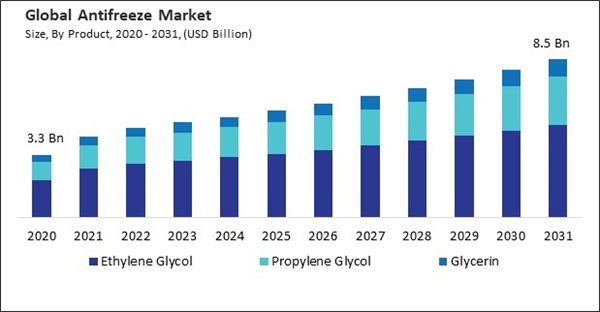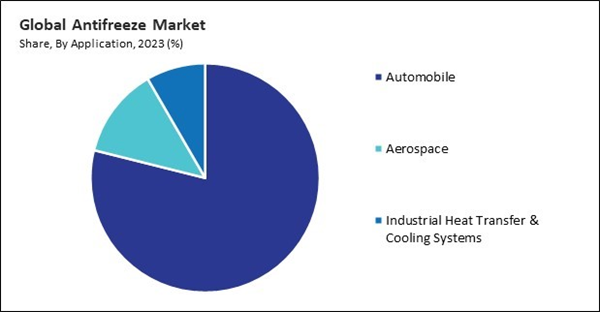Asia Pacific is home to some of the world's largest and fastest-growing automotive industries, including China, India, Japan, and South Korea. Therefore, the Asia Pacific region captured $2,471.2 Million revenue in the market in 2023. With increasing disposable incomes and awareness about vehicle maintenance, there is a growing trend among consumers and industries to use high-quality antifreeze products to protect their vehicles and equipment. Moreover, total consumption of Antifreeze in China was 629.95 Kilo Tonnes in 2023.
The construction sector relies heavily on various types of heavy machinery and equipment, like excavators, bulldozers, cranes, and loaders, which are equipped with cooling systems. This is essential for preventing freezing and maintaining optimal operating temperatures in construction equipment's cooling systems, especially in regions with cold climates. Thus, because of the expansion of the construction industry, the market is anticipated to increase significantly.
Additionally, green chemistry encourages using biodegradable ingredients and renewable resources in product formulations. These products made from biodegradable materials break down naturally into non-toxic substances when released into the environment, reducing pollution and minimizing harm to ecosystems. Therefore, the market is expanding significantly due to the focus on green chemistry and sustainable practices.
However, prices for raw materials used in antifreeze formulations, such as ethylene glycol and additives, can fluctuate, causing cost unpredictability for manufacturers. Rapid price changes can disrupt production planning, budgeting, and pricing strategies, impacting profitability and financial performance. Thus, price volatility of raw materials can slow down the growth of the market.
By Technology Analysis
By technology, the market is divided into organic acid technology (OAT), hybrid organic acid technology (HOAT), and inorganic additive technology (IAT). The hybrid organic acid technology (HOAT) segment acquired 20.6% revenue share in the market in 2023. HOAT-based antifreeze solutions typically offer extended service intervals compared to conventional coolants. Moreover, in terms of volume, the HOAT segment attained 925.8 Kilo Tonnes in the market in 2023.By Application Analysis
Based on application, the market is categorized into automobile, aerospace, and industrial heat transfer & cooling systems. In 2023, the automobile segment dominated the market with 78.9% revenue share. Vehicles are designed to last longer than ever before, leading to higher demand for maintenance products like antifreeze. Moreover, in terms of volume, the automobile segment attained 3,725.6 Kilo Tonnes in the market in 2023.By Product Analysis
On the basis of product, the market is segmented into ethylene glycol, propylene glycol, and glycerin. In 2023, the ethylene glycol segment held 60.0% revenue share in the market. Ethylene glycol is one of the primary ingredients used in the formulation of such products. The base fluid provides the necessary freeze and boil-over protection for vehicle cooling systems. Moreover, in terms of volume, the ethylene glycol segment registered 855.4 Kilo Tonnes in the market in 2023.By Regional Analysis
Region-wise, the market is analyzed across North America, Europe, Asia Pacific, and LAMEA. In 2023, the North America region acquired 24.9% revenue share in the market. North America experiences harsh winter conditions in many regions, particularly in northern states and Canada, where temperatures frequently drop below freezing. Moreover, in terms of volume, the US Market consumed 844.0 Kilo Tonnes Antifreeze in 2022.List of Key Companies Profiled
- Shell plc
- BASF SE
- Old World Industries, LLC
- SONAX GmbH
- Cummins, Inc.
- TotalEnergies SE
- AMSOIL Inc.
- Paras Lubricants Limited
- Exxon Mobil Corporation
- China Petrochemical Corporation
Market Report Segmentation
By Product (Volume, Kilo Tonnes, USD Billion, 2020-2031)- Ethylene Glycol
- Propylene Glycol
- Glycerin
- Organic Acid Technology (OAT)
- Hybrid Organic Acid Technology (HOAT)
- Inorganic Additive Technology (IAT)
- Automobile
- Aerospace
- Industrial Heat Transfer & Cooling Systems
- North America
- US
- Canada
- Mexico
- Rest of North America
- Europe
- Germany
- UK
- France
- Russia
- Spain
- Italy
- Rest of Europe
- Asia Pacific
- China
- Japan
- India
- South Korea
- Singapore
- Malaysia
- Rest of Asia Pacific
- LAMEA
- Brazil
- Argentina
- UAE
- Saudi Arabia
- South Africa
- Nigeria
- Rest of LAMEA
Table of Contents
Companies Mentioned
- Shell plc
- BASF SE
- Old World Industries, LLC
- SONAX GmbH
- Cummins, Inc.
- TotalEnergies SE
- AMSOIL Inc.
- Paras Lubricants Limited
- Exxon Mobil Corporation
- China Petrochemical Corporation










